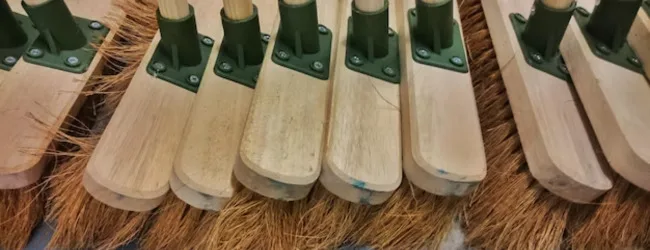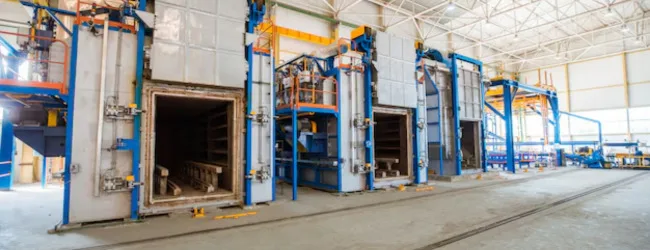Table of contents
- Why a Broom Manufacturing Business? An In-Depth Look
- Blueprint for a Booming Broom Manufacturing Business
- Phase 1: Foundation and Planning (Months 1-3)
- Phase 2: Setup and Production (Months 4-6)
- Phase 3: Marketing and Sales (Months 7-12)
- Phase 4: Expansion and Diversification (Year 2+)
- Need Expert Guidance?
- Conclusion
- Frequently Asked Questions (FAQs)
While the solar industry harnesses the sun’s power, the humble broom, an essential tool across every home and industry, presents a surprisingly fertile ground for entrepreneurial success. Launching a broom manufacturing business in India isn’t just about crafting a product; it’s about building a foundation for consistent, reliable income and creating a brand that resonates with everyday needs. This article outlines a blueprint to build a thriving broom manufacturing enterprise, where traditional craftsmanship meets modern market strategy, sweeping away the competition and ushering in substantial profits.
Why a Broom Manufacturing Business? An In-Depth Look

- Consistent Demand: The Unwavering Necessity:
- Elaboration:
- Brooms are not a luxury; they are a fundamental necessity across all socioeconomic strata. From the humblest rural home to the most sophisticated industrial complex, the need for cleaning and sweeping is constant.
- This consistent demand shields the business from the volatility of trends and fads that affect other industries.
- The demand is further driven by India’s vast population and the emphasis on hygiene, especially in urban areas.
- Furthermore, the industrial sector, including warehouses, factories, and commercial spaces, requires durable, specialized brooms, adding another layer of consistent demand.
- Even during economic downturns, the need for basic cleaning tools remains, ensuring a relatively stable market.
- This stability allows for more accurate forecasting and long-term business planning.
- Elaboration:
- Low Startup Costs: Accessibility and Reduced Risk:
- Elaboration:
- Compared to industries like electronics or automotive manufacturing, broom production requires significantly less capital investment.
- The basic machinery, such as cutting and binding tools, is relatively inexpensive and readily available.
- Initial facility setup can be modest, often utilizing existing spaces or rented premises.
- Raw material procurement can start on a small scale, allowing for gradual expansion.
- This low entry barrier makes the business accessible to entrepreneurs with limited capital, reducing financial risk.
- It enables a staged development of the business, where profits from initial sales can be reinvested to grow the company.
- Elaboration:
- Scalability: Growth Potential and Flexibility:
- Elaboration:
- A broom manufacturing business can begin as a small-scale cottage industry, utilizing manual labor and basic tools.
- As demand increases, production can be scaled up through the addition of machinery and workforce.
- Large-scale manufacturing plants can be established to meet the needs of regional and national markets.
- This scalability allows for flexibility in adjusting production to meet changing market demands.
- Diversification into related products, such as cleaning supplies or household items, can further enhance growth potential.
- The ability to scale allows for adapting to changing market conditions.
- Elaboration:
- Local Raw Material Availability: Cost Efficiency and Sustainability:
- Elaboration:
- India’s agricultural abundance provides a wealth of raw materials, including various types of grass, coconut fibers, and bamboo.
- The widespread availability of plastic recycling facilities also offers a cost-effective source of materials.
- Sourcing raw materials locally reduces transportation costs and lead times.
- Utilizing natural and recycled materials promotes sustainability and aligns with growing consumer awareness of environmental issues.
- This local resource base can lead to strong, sustainable supply chains.
- By utilizing local resources, the business becomes less vulnerable to global supply chain issues.
- Elaboration:
- Rural Employment Opportunities: Social Impact and Community Development:
- Elaboration:
- Broom manufacturing can create significant employment opportunities in rural areas, where job prospects are often limited.
- This can help reduce rural-to-urban migration and promote economic development in underserved communities.
- The business can empower women and other marginalized groups by providing them with income-generating opportunities.
- By supporting local economies, broom manufacturing businesses can contribute to social stability and community well-being.
- This also creates a more loyal workforce, that has a vested intrest in the company.
- This business model allows for the retention of traditional skills, and crafts.
- Elaboration:
Blueprint for a Booming Broom Manufacturing Business
Phase 1: Foundation and Planning (Months 1-3)

Step 1: Detailed Market Research & Niche Identification (Weeks 1-4)
- Week 1: Macro-Market Analysis:
- Research the overall size and growth of the Indian broom market.
- Analyze national consumption patterns and regional variations.
- Study the impact of urbanization and changing consumer lifestyles.
- Investigate the role of government initiatives related to MSMEs.
- Week 2: Micro-Market Segmentation:
- Identify specific market segments: household, industrial, commercial, and niche (eco-friendly, specialized).
- Analyze the demand for different broom types: grass, coconut fiber, plastic, synthetic, etc.
- Determine price sensitivity and purchasing habits of each segment.
- Week 3: Competitive Landscape Analysis:
- Identify key competitors (local, regional, national).
- Analyze their product offerings, pricing, distribution, and marketing strategies.
- Identify gaps in the market and potential for differentiation.
- Research online presence of competitors.
- Week 4: Niche Selection & Product Diversification:
- Select a primary niche based on market demand and competitive analysis.
- Brainstorm potential product variations and customizations.
- Conduct preliminary product testing and gather feedback from potential customers.
- Begin to plan out packaging ideas.
Step 2: Detailed Business Plan Development (Weeks 5-8)
- Week 5: Executive Summary & Company Description:
- Craft a compelling executive summary highlighting the business’s vision and potential.
- Develop a detailed company description, including legal structure, ownership, and mission.
- Create a SWOT analysis.
- Week 6: Market Analysis & Marketing Strategy:
- Detail your target market, market size, and growth potential.
- Outline your marketing strategy: branding, advertising, sales channels, and customer acquisition.
- Plan out social media presence.
- Week 7: Operations & Management Plan:
- Detail the manufacturing process, equipment, and raw material sourcing.
- Develop an organizational chart and define roles and responsibilities.
- Create a production schedule and inventory management system.
- Plan out quality control processes.
- Week 8: Financial Projections & Funding Strategy:
- Develop detailed financial projections: startup costs, operating expenses, revenue forecasts, and profitability analysis.
- Create a funding strategy: loan applications, investor pitches, and bootstrapping.
- Create a break even analysis.
Step 3: Legal & Regulatory Compliance (Weeks 9-12)
- Week 9: Business Registration & Licensing:
- Select a suitable business structure (sole proprietorship, partnership, LLP, or private limited company).
- Complete business registration and obtain necessary licenses and permits.
- Research local municipality regulations.
- Week 10: GST Registration & Labor Laws:
- Obtain GST registration and understand tax compliance requirements.
- Research and comply with labor laws: minimum wage, working hours, and employee benefits.
- Consult a labour lawyer.
- Week 11: Environmental & Safety Regulations:
- Research and comply with environmental regulations related to waste disposal and pollution control.
- Implement safety measures to protect workers and prevent accidents.
- Obtain necessary safety certifications.
- Week 12: Contractual Agreements & Insurance:
- Develop standard contractual agreements for suppliers, distributors, and customers.
- Obtain necessary insurance coverage: liability, property, and workers’ compensation.
- Consult with an insurance broker.
💡 Pro Tip: If you want to start a business but have too many doubts, connect with a food business expert from Boss Wallah for guidance – https://bw1.in/1116
Phase 2: Setup and Production (Months 4-6)

Step 4: Securing Funding (Weeks 13-16)
- Week 13: Loan Application Preparation:
- Prepare detailed loan applications with supporting documents: business plan, financial statements, and collateral information.
- Research government schemes and MSME loan options.
- Week 14: Investor Pitch Development:
- Develop a compelling investor pitch deck and presentation.
- Network with potential investors and attend industry events.
- Week 15: Microfinance & Local Bank Options:
- Explore microfinance institutions and local bank loan options.
- Negotiate favorable loan terms and interest rates.
- Week 16: Finalizing Funding & Budget Allocation:
- Finalize funding agreements and allocate budget to key areas: equipment, raw materials, and operating expenses.
ALSO READ | How to Start Wire Manufacturing Business? Earn Crores in 10 Easy Steps
Step 5: Facility Setup & Equipment Procurement (Weeks 17-20)
- Week 17: Facility Location & Layout Planning:
- Select a suitable location based on proximity to raw materials, transportation, and labor availability.
- Develop a detailed facility layout for efficient production flow and storage.
- Week 18: Equipment Selection & Procurement:
- Research and select reliable equipment suppliers: cutting machines, binding machines, drying racks, etc.
- Obtain quotes and negotiate favorable purchase agreements.
- Week 19: Infrastructure Setup & Utilities:
- Set up necessary infrastructure: power supply, water supply, and ventilation.
- Arrange for utilities and internet connectivity.
- Week 20: Equipment Installation & Testing:
- Install and test all equipment to ensure proper functioning.
- Train workers on equipment operation and maintenance.
Step 6: Raw Material Sourcing & Workforce Training (Weeks 21-24)
- Week 21: Raw Material Supplier Identification:
- Identify reliable suppliers for raw materials: grass, coconut fibers, plastic, etc.
- Establish relationships with local farmers, traders, and manufacturers.
- Week 22: Quality Control & Inventory Management:
- Implement quality control measures for raw materials.
- Develop an inventory management system to track stock levels and prevent shortages.
- Week 23: Workforce Recruitment & Training:
- Recruit skilled and unskilled workers for production and management roles.
- Develop a comprehensive training program on production techniques and quality control.
- Week 24: Standard Operating Procedures (SOPs) Development:
- Develop detailed SOPs for all production processes.
- Conduct regular training sessions and performance evaluations.
Phase 3: Marketing and Sales (Months 7-12)

Step 7: Production and Quality Control (Weeks 25-36)
- Weeks 25-28: Pilot Production & Process Refinement:
- Conduct small-scale pilot production runs to test equipment and processes.
- Identify and address any bottlenecks or inefficiencies in the production line.
- Fine-tune production parameters to ensure consistent product quality.
- Document all production steps for future reference.
- Weeks 29-32: Quality Control System Implementation:
- Establish a comprehensive quality control system at each stage of production.
- Develop standardized quality checklists and inspection protocols.
- Train quality control personnel on testing procedures and defect identification.
- Implement a system for tracking and addressing customer complaints.
- Weeks 33-36: Production Optimization & Cost Reduction:
- Analyze production data to identify areas for cost reduction and efficiency improvement.
- Implement lean manufacturing principles to minimize waste and maximize output.
- Explore automation options to increase productivity and reduce labor costs.
- Regularly review raw material purchasing for better pricing.
Step 8: Marketing and Distribution (Weeks 37-44)
- Weeks 37-38: Brand Identity & Marketing Materials Development:
- Develop a unique brand identity, including a logo, tagline, and brand story.
- Create high-quality marketing materials: brochures, flyers, and product catalogs.
- Design packaging that is visually appealing and informative.
- Create a company website.
- Weeks 39-40: Digital Marketing & Online Presence:
- Develop a comprehensive digital marketing strategy: social media, SEO, and online advertising.
- Create engaging content for social media platforms and blogs.
- Optimize website for search engines and build an online store.
- Setup google my business.
- Weeks 41-42: Distribution Channel Development:
- Identify and establish relationships with potential distributors and retailers.
- Explore opportunities for direct sales to industrial and commercial clients.
- Set up a logistics and delivery system for efficient product distribution.
- Explore E-Commerce platforms.
- Weeks 43-44: Sales Promotion & Customer Engagement:
- Develop sales promotion strategies: discounts, bundles, and loyalty programs.
- Participate in local trade shows and exhibitions.
- Implement a customer relationship management (CRM) system to track customer interactions.
- Create customer surveys for feedback.
Step 9: Launch and Sales Growth (Weeks 45-52)
- Weeks 45-46: Product Launch & Initial Sales:
- Launch your products through selected distribution channels.
- Monitor initial sales performance and gather customer feedback.
- Implement a system for tracking sales data and generating reports.
- Weeks 47-48: Customer Feedback & Product Adjustments:
- Collect and analyze customer feedback to identify areas for product improvement.
- Make necessary adjustments to product design, packaging, and marketing materials.
- Implement a system for addressing customer complaints and providing after-sales support.
- Weeks 49-50: Sales Growth & Expansion Planning:
- Develop a sales growth strategy based on initial sales data and market trends.
- Begin planning for production expansion and market diversification.
- Analyze best selling products.
- Weeks 51-52: Building Strategic Partnerships:
- Seek out strategic partnerships with other businesses to expand market reach.
- Explore collaborations with cleaning service companies, retailers, and industrial clients.
- Create joint marketing campaigns.
Phase 4: Expansion and Diversification (Year 2+)

Step 10: Scaling and Diversification (Year 2+)
- Year 2: Production Capacity Expansion & Automation:
- Invest in additional equipment and expand manufacturing facilities to increase production capacity.
- Explore automation options to improve efficiency and reduce labor costs.
- Implement a system for tracking and managing inventory levels.
- Year 2: Market Diversification & Export Opportunities:
- Explore opportunities to expand into new markets: regional, national, and international.
- Research export regulations and identify potential export markets.
- Adapt products and packaging to meet international standards.
- Year 3: Product Diversification & Innovation:
- Invest in research and development to create new and innovative broom products.
- Explore opportunities to diversify into related cleaning supplies and household items.
- Create eco-friendly product lines.
- Year 3: Strategic Acquisitions & Partnerships:
- Explore strategic acquisitions of complementary businesses to expand market share.
- Form strategic partnerships with other manufacturers, distributors, and retailers.
- Look to licensing your products.
- Year 4+: Continuous Improvement & Sustainability:
- Implement a continuous improvement program to optimize production processes and reduce costs.
- Adopt sustainable manufacturing practices to minimize environmental impact.
- Invest in employee training and development to enhance workforce skills.
- Look into vertical integration of raw material production.
Need Expert Guidance?
Starting a business can be challenging, but you don’t have to do it alone! At Boss Wallah, our 2,000+ business experts are ready to provide valuable insights and guidance. Whether you need help with marketing, finance, sourcing, or any other area of any business, our business experts are here to help you succeed- https://bw1.in/1116
Confused about Which Business to Start?
Want to start your own business but unsure which one to choose? Explore Boss Wallah, where you’ll find 500+ courses by successful business owners, featuring practical, step-by-step guides on starting and growing various businesses.
Find your perfect business idea today – https://bw1.in/1111
Conclusion
The opportunity to build a thriving broom manufacturing business in India is not merely about producing a simple household item; it’s about crafting a sustainable enterprise that meets fundamental needs, creates employment, and generates consistent revenue. By adhering to this hyper-detailed blueprint, you can navigate the complexities of market research, production, marketing, and expansion with precision. From meticulous planning and legal compliance to strategic funding and operational excellence, each step is designed to optimize your business for success. Embracing innovation, prioritizing quality, and focusing on customer satisfaction will enable you to sweep away the competition and build a legacy of growth and profitability within the dynamic Indian market.
Frequently Asked Questions (FAQs)
- What are the key market segments for a broom manufacturing business in India?
- Household, industrial, commercial, and niche markets (eco-friendly, specialized).
- How much initial investment is required to start a broom manufacturing business?
- The investment varies depending on the scale, but it can range from a few lakhs for small-scale operations to crores for larger plants. Detailed financial planning is crucial.
- What are the essential licenses and permits required for this business?
- Business registration, GST registration, and compliance with local labor and environmental regulations are essential.
- Where can I source reliable raw materials for broom manufacturing?
- Local farmers, traders, and manufacturers are primary sources. Establishing strong supplier relationships is vital.
- What types of equipment are necessary for broom production?
- Cutting machines, binding machines, drying racks, and other tools depending on the type of broom being made.
- How can I effectively market and distribute my broom products?
- Develop a strong brand identity, utilize digital marketing, establish distribution channels (local markets, retail stores, online platforms), and explore bulk orders.
- What are the key factors for ensuring high-quality broom production?
- Implementing rigorous quality control systems, using quality raw material, and training workers on proper manufacturing techniques.
- What are the opportunities for scaling and expanding a broom manufacturing business?
- Expanding production capacity, diversifying into related products, exploring export opportunities, and automating processes.


